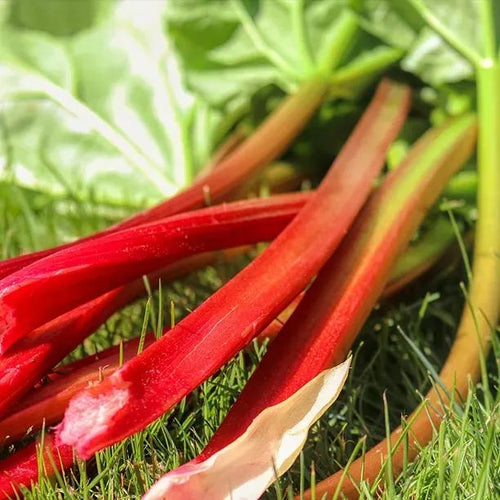Victoria Rhubarb Plants
Victoria is a tried and tested variety with an easy temperament and enormous output. The stems are large with very good flavour and the plant makes an enormous clump when full grown in summer. The stalk is solid pink at the bottom, becoming green with pink speckles and ending up fully green at the leaf end. Victoria is notable for being less stringy than many other varieties. It's the latest to produce stems of the spring varieties, being most productive between May and July.
Browse our other varieties of rhubarb.
Victoria is also a good rhubarb to try to force in which case you will have pale pink stems in February to March. Forcing rhubarb requires covering it during the winter with an old dustbin or with a decorative terracotta forcer. This makes the environment warm and dark so that the stems emerge as palest pink and more spindly than if left to fend for themselves in normal conditions. The result is a delicacy so it's well worth trying but it does exhaust the plant. You need to give it a rest for a year or two after forcing and not take any stems during that time.
Growing Rhubarb
The thing about rhubarb is that it completely disappears in winter but needs plenty of space in summer. Its large, architectural leaves are handsome and look magnificent in a potager. Once planted they can be left to themselves but are so much happier if you can mulch them in spring with lots of compost and, if it promises to be very cold, to cover them with straw in the winter to keep the frost off the crowns. They require lots of nitrogen when young so dig in masses of muck into the planting hole. Rhubarb likes damp summers; if it's too hot and dry in the summer rhubarb tends to bolt so make sure you give your plant plenty of water during dry spells. Conversely rhubarb can rot in winter if the soil is waterlogged so if your soil is very heavy and wet, plant the crown on top of a mound of soil so that it's slightly raised. After planting, do not pull the stems the first year to allow the crown to gather strength. In the second year and onwards make sure you pick every stem periodically by pulling and twisting the stem away to encourage more to be formed. It's a bit like pulling a globe artichoke leaf off the main choke. Do not cut the stem.
Features
- Height: 60 cm
- Spread: 1 m
- Fruit: non-stringy stems
- Taste: full flavour, tart
- Use: cooking/forcing
- Picking: May-July
- Colour: pink/green
- Spacing: 1.2 m
History & Trivia
The Chinese have been grinding up rhubarb roots since B.C. 2500 and using them as herbal purgative. The plant was not grown here until the late 1700s. But it took until the late 1800s for rhubarb to become really established in the pudding department, mainly because of the repeal of the sugar tax in 1874. If you add a Sweet Cicely leaf to your rhubarb when you are cooking it, you will need less sugar to balance the tartness. Victoria was introduced by Joseph Myatt in 1837.

 Secure, One-Tap Checkout
Secure, One-Tap Checkout
 Hand Picked, Delivered to Your Door!
Hand Picked, Delivered to Your Door! 1 Year Bareroot Guarantee
1 Year Bareroot Guarantee


